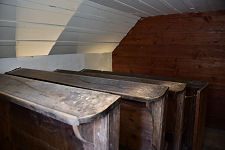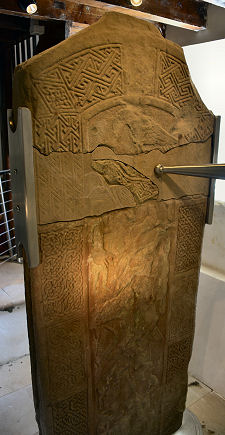 Nigg Old Church |
Nigg is separated from the attractive and historic town of Cromarty by the width, less than a mile, of the mouth of the Cromarty Firth. Despite their proximity, as you drive past Nigg's huge marine fabrication yards you could be forgiven for thinking the two are actually on different planets. But turn inland to the tiny settlement of Nigg itself and you quickly realise the force of history is every bit as strong on the north side of the Cromarty Firth as on the south, even if you do have to look a little harder to find it.
Nigg Old Church entered recorded history 1296, when its parson swore loyalty to King Edward I of England. In subsequent centuries it formed part of the landholdings of the Bishop of Ross. Until the 1500s the church would have been a simple oblong in shape with an altar at the eastern end. After the Reformation of 1560 the focus would have changed to the pulpit, probably placed in a central location. The church was rebuilt in 1626 and was probably in its current T-shaped layout then.
But a church dating back at least 700 years isn't Nigg's most striking reminder of the past. This comes in the form of the Nigg Stone, a magnificent Pictish carved cross slab standing some 2.1m high by 1.05m wide in a dedicated room at the west end of the church. We've seen it described as "approaching more nearly to the ornamental pages of the Irish books of the gospel than any other sculpture in the British Isles"; as "one of the finest surviving Pictish carved stones, and one of the most elaborate carved stones surviving from early medieval Europe"; and as deserving "a place second to none in the history of Western medieval art." It is certainly pretty spectacular, even by the supremely high standards of other Pictish carved stones in Scotland. (Continues below images...)
 Nigg Cross Slab in West End of Church |
 Upper Part of Front of the Nigg Cross Slab |
The Nigg cross slab probably dates back to the late 700s or early 800s and could well indicate a Christian place of worship on the site later occupied by the church dating back at least that far. It stood for centuries in the kirkyard until it was blown down in a gale in 1725 (or 1727, or 1729, depending on your source). It was later re-erected, then broken, then largely forgotten for a century until its importance began again to be recognised in the late 1800s. It was finally moved into the protection of the church in 1978 and what you see today is the result of major conservation work in 2012/13.
The front of the stone is much less weathered than the rear. Here the design is topped off with a depiction of St Paul meeting St Anthony in the desert and having bread delivered by a raven. The rest of the front is made up of a stunningly elaborate carved cross surrounded by magnificent decorations. The rear is both eroded and flaked, but the quality of the carving and decoration remains obvious, and it is possible to make out (though we couldn't ourselves) a hunting scene and a variety of Pictish symbols plus, perhaps, David fending off the lion.
It is probably fair to say that many visitors come to Nigg Old Church simply to see the Nigg Stone. But it's worth recognising that it isn't the only thing worth looking at here. We've talked about the layout of the church itself, which like many after the Reformation made the pulpit the absolute and only focus of attention for all those attending the services. That is certainly the case here.
Also of interest are the communion tables, which appear in the photo of the church interior on this page and, to those unfamiliar with church rites, can seem odd. After the Reformation, churches only celebrated communion once or twice a year. As a result attendance could be very high. Groups of communicants sat around long tables, one group after another with each in turn taking part in a communion service. As a result the complete event could last throughout the day. Also of interest are the stairs beside the Nigg Stone, which lead up to a poor loft, perfectly preserved having simply been partitioned off and abandoned during renovations in 1853.
It is also worth taking a look around the kirkyard, which has a wealth of old and interesting gravestones. Symbols of mortality like skulls, crossed bones and hourglasses occur frequently. For several centuries after the Reformation they replaced symbols such as the cross on gravestones in the Church of Scotland, being seen as being too closely associated with the old church. There is also a sign indicating the Cholera Stone, placed here in 1832 to cap off what was believed to be a source of the disease.
 The Nigg Cross Slab on Display |

|
|
|
Visitor InformationView Location on MapGrid Ref: NH 805 717 www.niggoldtrust.org.uk What3Words Location: ///outfitter.total.glider |
 Rear of Church |
 Pulpit |
 Church Interior |
 Closed-Off Poor Loft |
 Box Tomb |
 Symbols of Mortality in Kirkyard |
 The Cholera Stone |
 The Raven |




